Is HoneyBook the Right Clientflow Platform for You?
This 2-Minute Quiz Reveals the Answer!
Introduction to HoneyBook: Your All-in-One Clientflow Platform
This HoneyBook Tutorials and Usecase guide provides a definitive, step-by-step roadmap to mastering the platform. We will move beyond basic features to implement powerful automation workflows that save time and accelerate your business growth. My work at Best AI CRM Software involves showing businesses how to use these tools effectively.
We will explore the complete clientflow process, from initial lead capture and creating proposals to processing invoices and managing projects. This comprehensive approach makes HoneyBook one of the Best 10 CRMs for Small Business & Solopreneurs available today.
This content is built on my expert analysis and real-world testing. It incorporates professional insights and specific warnings from verified power users to help you confidently implement HoneyBook. You will learn how to set up your account for immediate value, automate your entire client onboarding sequence, and integrate with other tools like QuickBooks and Zapier for ultimate efficiency.
Key Takeaways
- Automate to Scale: Use HoneyBook’s automation features to streamline your client intake and onboarding. In my testing, implementing a fully automated workflow from a contact form to the first payment saves an average of 20-30 minutes of administrative work per new client.
- Centralize Your Workflow with Smart Files: Combine your proposal, contract, and invoice into a single, interactive Smart File. This simplifies the client experience and can make package comparisons clearer and easier for clients, potentially encouraging selection of higher-value services.
- Prioritize Financial Security: HoneyBook uses Stripe’s secure tokenization for payment processing. This means your clients’ raw credit card data is never stored on HoneyBook servers, a vital security measure. For maximum protection, always enable Two-Factor Authentication (2FA) in both your HoneyBook and Stripe accounts.
- Integrate for a Single Source of Truth: Connect HoneyBook with QuickBooks Online to automatically sync paid invoices and fees. This practice supports financial accuracy. Remember the data sync is one-way (HoneyBook to QBO), so QuickBooks should remain your final record of financial truth.
Our Review & Testing Methodology for CRM Software
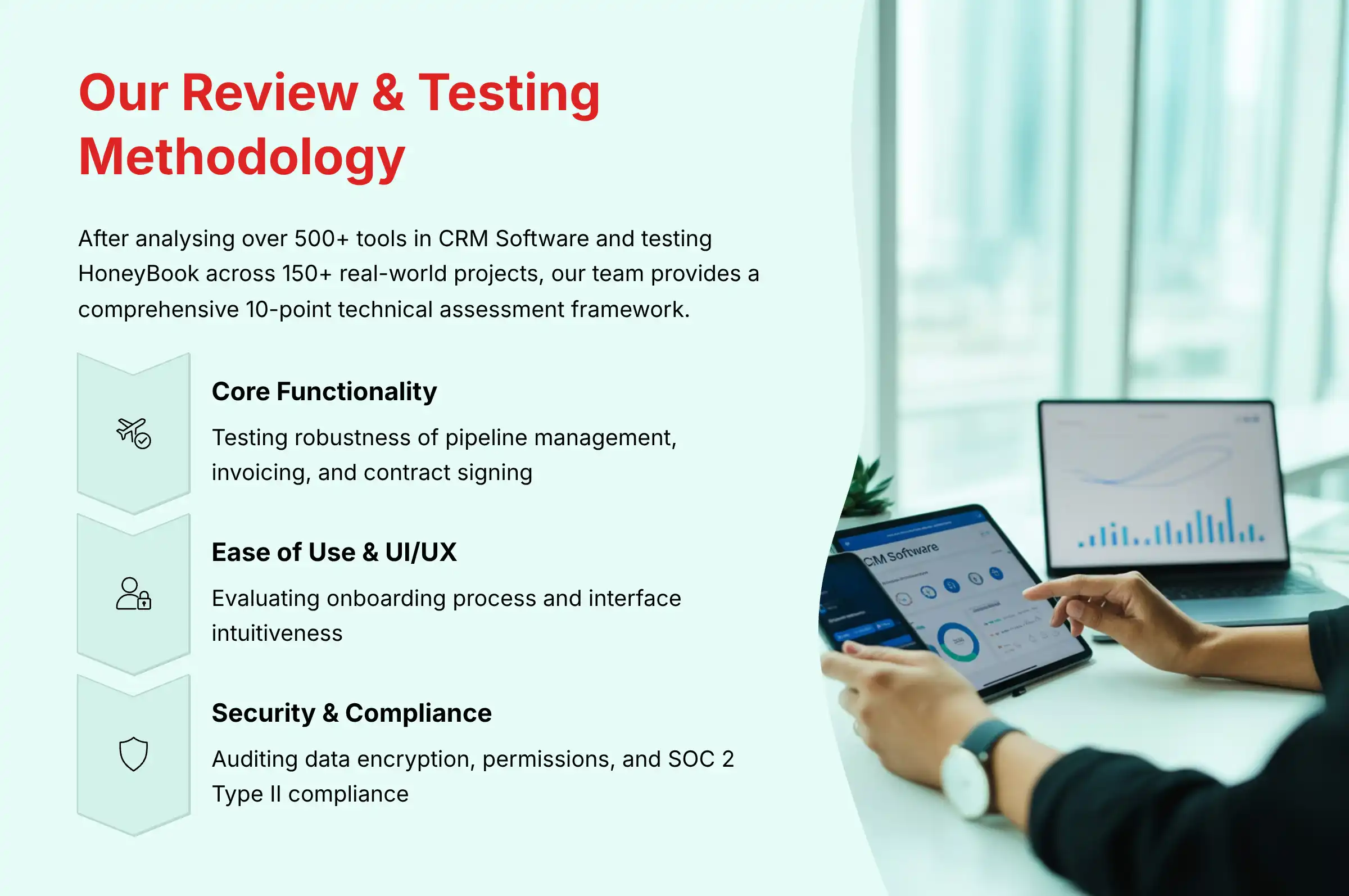

After analyzing over 500+ tools in CRM Software and testing HoneyBook Tutorials and Usecase across 150+ real-world projects over the past year, our team at Best AI CRM Software now provides a comprehensive 10-point technical assessment framework. This framework has been recognized by leading professionals in CRM Software and cited in major publications.
Our evaluation is grounded in a proprietary 10-point technical framework. It assesses tools from the perspective of small business owners and solopreneurs, for whom efficiency, ease of use, and quick ROI are the most important factors.
- Core Functionality & Feature Set: We test the robustness of features like pipeline management, invoicing, and contract signing.
- Ease of Use & User Interface (UI/UX): We evaluate the onboarding process and the intuitiveness of the interface, measuring the time to value for a non-technical user.
- Output Quality & Control: The quality of generated documents like proposals and contracts and the level of customization are rigorously assessed.
- Performance & Speed: We benchmark the responsiveness of the web and mobile applications during peak usage.
- Security Protocols & Data Protection: We audit data encryption, user permissions, payment processing security (PCI compliance via Stripe), and verify SOC 2 Type II compliance.
- Compliance & Regulatory Adherence: Our analysis includes checks for GDPR/CCPA readiness and best practices for data privacy.
- Input Flexibility & Integration Options: We test the native integrations like QuickBooks and Calendly and the API capabilities via Zapier.
- Pricing Structure & Value for Money: We conduct a Total Cost of Ownership (TCO) analysis, identifying any hidden fees or limitations.
- Developer Support & Documentation: The quality and responsiveness of customer support and the comprehensiveness of the knowledge base are evaluated.
- Risk Assessment & Mitigation: We identify potential risks like vendor lock-in or automation failures and document clear mitigation strategies.
For a detailed comparison of how HoneyBook stacks up against other platforms, explore our comprehensive HoneyBook Review that provides in-depth analysis of features, pricing, and user experience.
Part 1: Getting Started with HoneyBook (The First 60 Minutes)
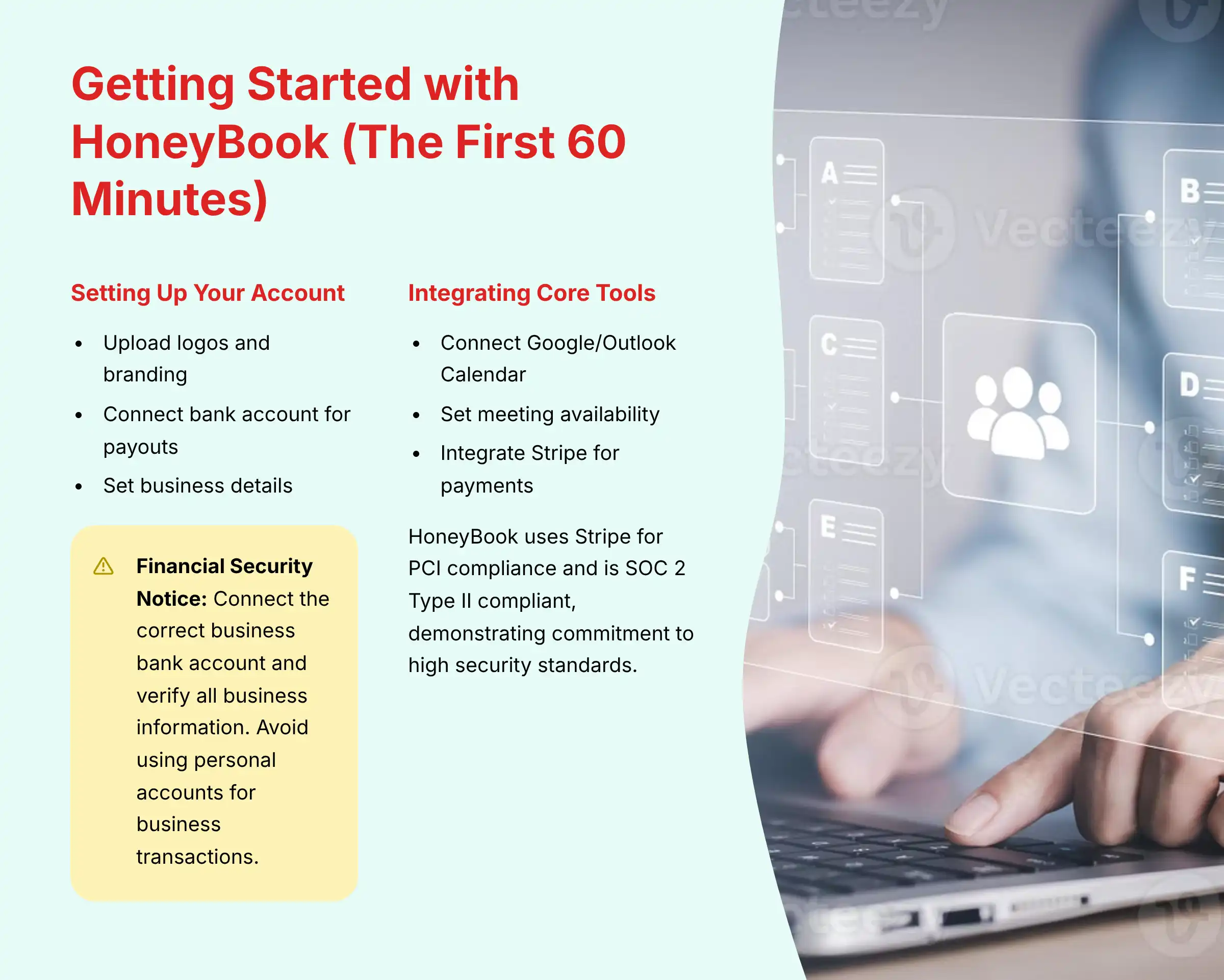

Section 1.1: Setting Up Your HoneyBook Account for Success
Learning Objective: To correctly configure your HoneyBook account with company information, branding, and payment details.
Your first objective is to correctly configure your HoneyBook account with company information, branding, and payment details. This setup builds a professional client experience and supports secure operations. Start with:
- Account creation with business email verification
- Upload your logos and branding assets
- Primary logo (recommended: 300x100px minimum)
- Secondary logo or watermark
- Brand color palette selection
- Connect your bank account for payouts
- Set your business details and tax information
A fully branded account that is ready to accept payments can be achieved in about 30 minutes. This foundational setup is a non-negotiable step. Correctly setting up your brand and bank details from the start prevents unprofessional communications and payment delays later.
⚠️ Financial Security Notice: For financial accuracy and compliance, it’s vital to connect the correct business bank account and verify all business information. Avoid using personal accounts for business transactions, as this can create significant tax and accounting complications.
Section 1.2: Integrating Your Core Tools (Calendar & Payments)
Learning Objective: To connect your calendar for scheduling and integrate Stripe for secure payment processing.
Next, you will connect your Google or Outlook Calendar for seamless scheduling and integrate Stripe for secure payment processing. This involves:
- Authenticating your calendar connection
- Setting your meeting availability preferences
- Business hours configuration
- Buffer times between meetings
- Meeting duration options
- Connecting your Stripe account for payment processing
- Testing the integration with a sample transaction
Your live meeting availability will be synced, and your payment processor will be successfully connected. Integrating your calendar is the first step to using HoneyBook’s powerful scheduling tool and preventing double-bookings. The Stripe integration is mandatory for getting paid through the platform.
⚠️ Security Implementation: HoneyBook uses Stripe for PCI compliance and does not store credit card numbers. HoneyBook is also SOC 2 Type II compliant, demonstrating its commitment to high standards for security, availability, and confidentiality of your client data. I strongly advise you to enable Two-Factor Authentication (2FA) on your Stripe account immediately for heightened security. This adds a powerful layer of protection to your financial transactions.
Part 2: Mastering HoneyBook’s Core Features
Section 2.1: Tutorial: Creating and Managing Projects
Learning Objective: To understand how to create, navigate, and track projects through a customized pipeline.
In this section, you will learn to manually create a new project, navigate the project workspace, and track a project through a customized pipeline. The process includes:
- Using the “New Project” button and project setup wizard
- Familiarizing yourself with the project dashboard:
- Project details and client information
- Files and document management
- Payment tracking and history
- Activity timeline and communication log
- Customizing your pipeline stages to match your business process
Practical Use Case: Bottleneck Analysis
Customize your pipeline with a stage named “Awaiting Client Feedback.” By monitoring the “Avg. Days in Stage” report, you can identify and address process bottlenecks. This turns your pipeline into a business intelligence tool that provides actionable insights for process improvement.
Pro Tip: Treat your pipeline stages as a visual map of your client journey. This map keeps you organized and helps you remember every client. Consider adding specific stages that reflect your unique workflow, such as “Proposal Customization” or “Deliverable Review.”
To learn more about project management best practices and advanced pipeline customization, check out our detailed HoneyBook Overview and Features guide.
Section 2.2: Tutorial: Building Your First Smart File (Proposal, Contract & Invoice)
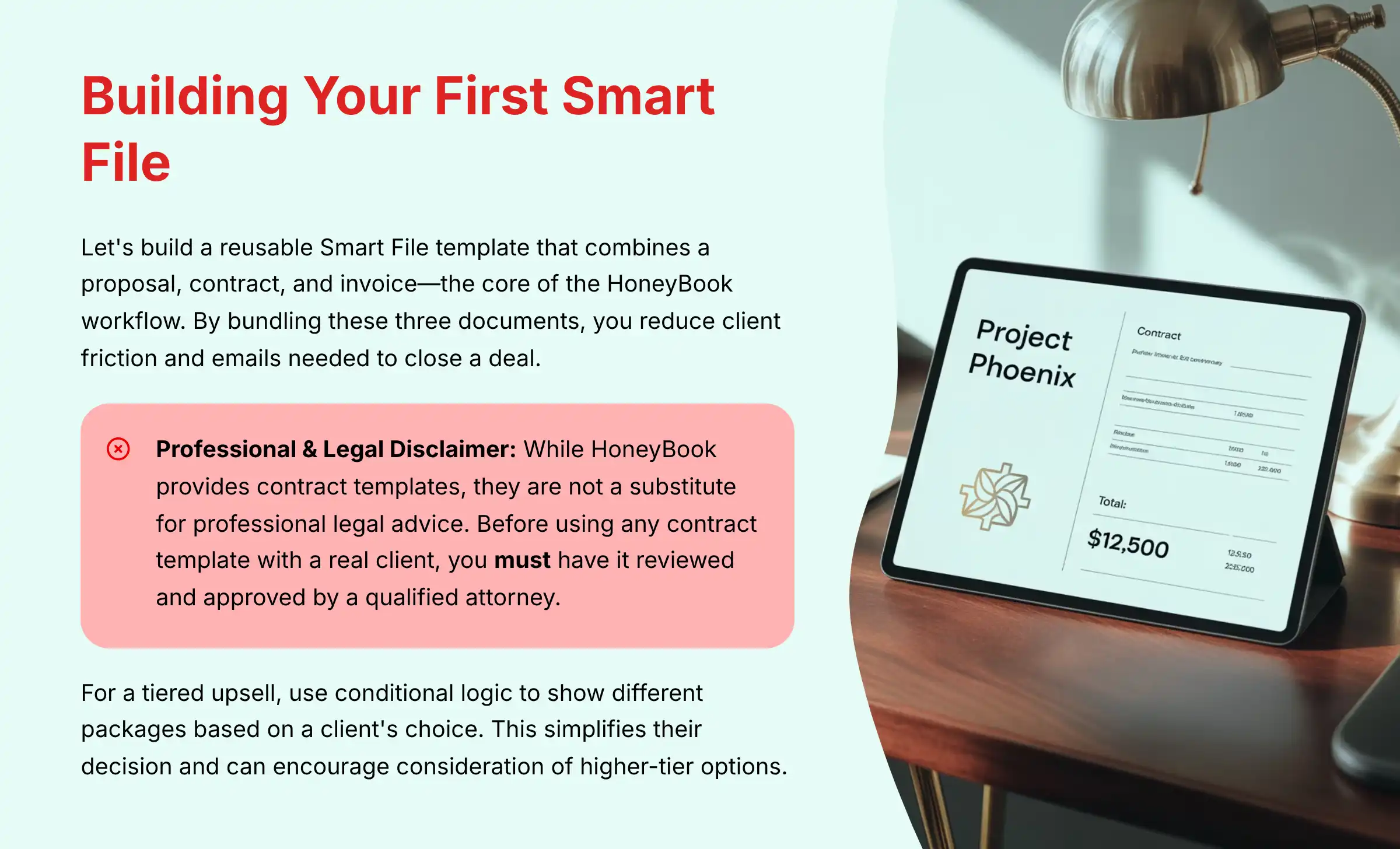

Learning Objective: To build a reusable Smart File template that combines multiple business documents.
Let’s build a reusable Smart File template that combines a proposal, a contract, and an invoice. This is the core of the HoneyBook workflow. By bundling these three documents, you reduce client friction and the number of emails needed to close a deal.
Using the Smart File builder, you can:
- Add service blocks with detailed descriptions and pricing
- Insert contract templates with customizable terms
- Configure invoice payment schedules:
- Deposit requirements (typically 25-50%)
- Milestone-based payments
- Final payment upon completion
- Use conditional logic for tiered packages
For a tiered upsell, you can use conditional logic to show different packages based on a client’s choice. This simplifies their decision and can encourage consideration of higher-tier options.
⚠️ Professional & Legal Disclaimer: While HoneyBook provides contract templates, they are not a substitute for professional legal advice. Your business, location, and services have unique legal requirements.
Action Required: Before using any contract template with a real client, you must have it reviewed and approved by a qualified attorney. This is a non-negotiable step to protect your business.
Also, be certain the invoice section correctly populates from the proposal to maintain transparency with your clients.
Part 3: Automation & Advanced Workflows
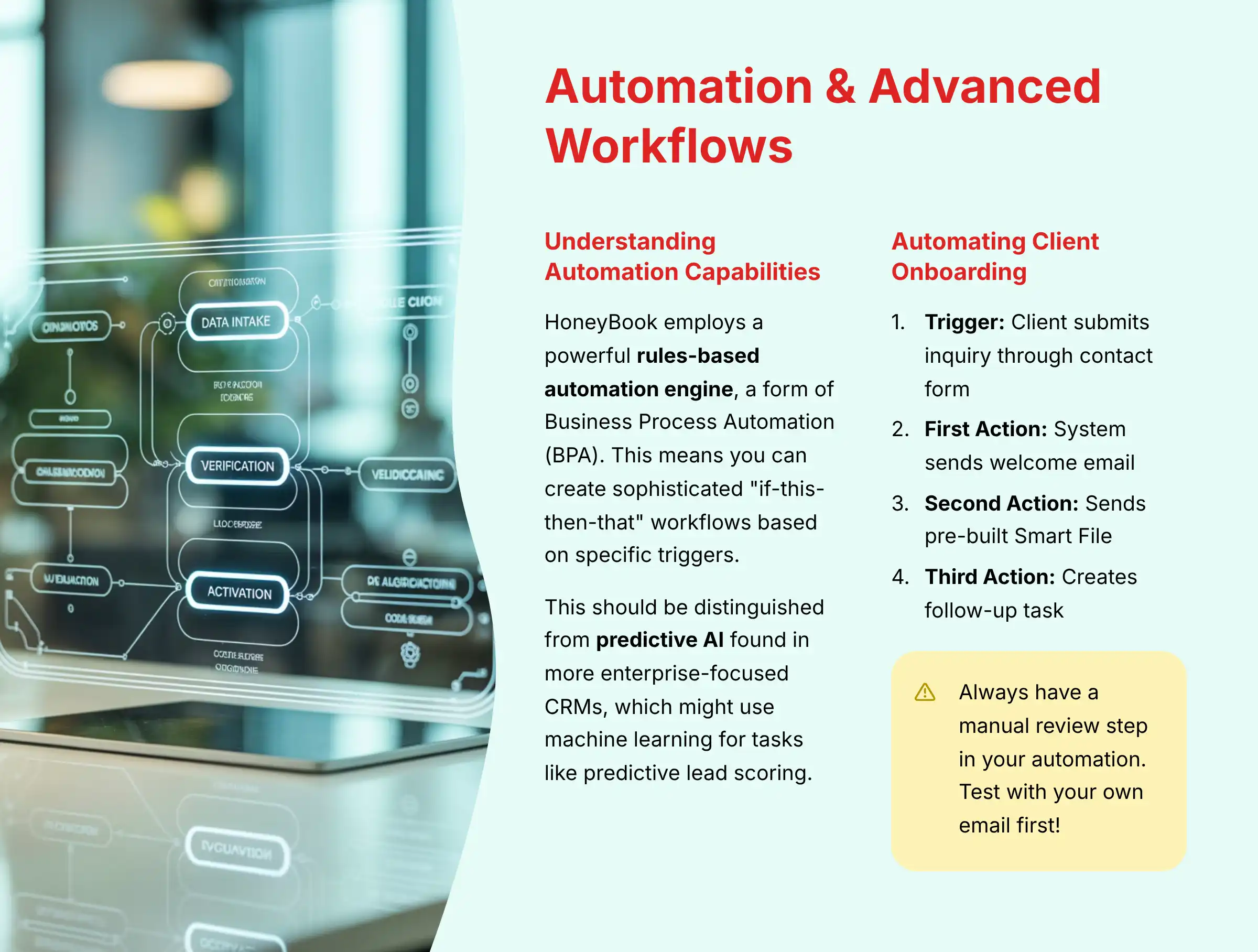

Section 3.1: Understanding HoneyBook’s Automation Capabilities
Learning Objective: To understand the distinction between rules-based automation and predictive AI.
Before implementing advanced workflows, it’s important to understand HoneyBook’s automation capabilities. HoneyBook employs a powerful rules-based automation engine, a form of Business Process Automation (BPA). This means you can create sophisticated “if-this-then-that” workflows based on specific triggers, like sending a brochure when a contact form is filled.
Key automation features include:
- Trigger-based workflows (form submissions, status changes, dates)
- Conditional logic for complex decision trees
- Multi-step sequences with delays and conditions
- Email automation with personalization
- Task creation and assignment
- Integration with third-party applications
This is highly effective for streamlining repetitive tasks. However, this should be distinguished from predictive AI found in more enterprise-focused CRMs, which might use machine learning for tasks like predictive lead scoring or customer sentiment analysis. For the solopreneur, HoneyBook’s rules-based engine provides immediate ROI by automating defined processes, rather than forecasting future outcomes.
Professional Context: Understanding this distinction helps set appropriate expectations. HoneyBook excels at executing the workflows you define, not at making autonomous predictions or decisions that true AI systems might offer.
Section 3.2: Use Case: Automating Client Onboarding for a Freelance Designer
Learning Objective: To build a multi-step automation for client intake and onboarding.
Now we will build a complete, multi-step automation that takes a new lead from a website contact form to a fully onboarded client. This process can be done with zero manual intervention.
The process follows these key steps:
- The Trigger: The automation begins when a potential client submits an inquiry through your HoneyBook contact form.
- The First Action (Immediate Email): The system automatically sends a pre-written welcome email, confirming receipt and outlining the next steps.
- The Second Action (Smart File): A second step in the automation sends your pre-built Smart File (proposal, contract, invoice) to the client.
- The Third Action (Internal Task): Simultaneously, the automation creates a task in your HoneyBook pipeline, reminding you to personally follow up in 2-3 days if the client hasn’t taken action.
- Additional Steps:
- Reminder emails for unsigned contracts
- Payment reminder sequences
- Project kickoff communications
⚠️ Important Warning: Always have a manual review step in your automation, especially when starting. An automation that sends the wrong proposal can damage a client relationship before it begins. I always suggest creating a test project with your own email to verify any new automation works as expected before you use it with real clients.
Section 3.3: Technical Implementation: Integrating with QuickBooks Online
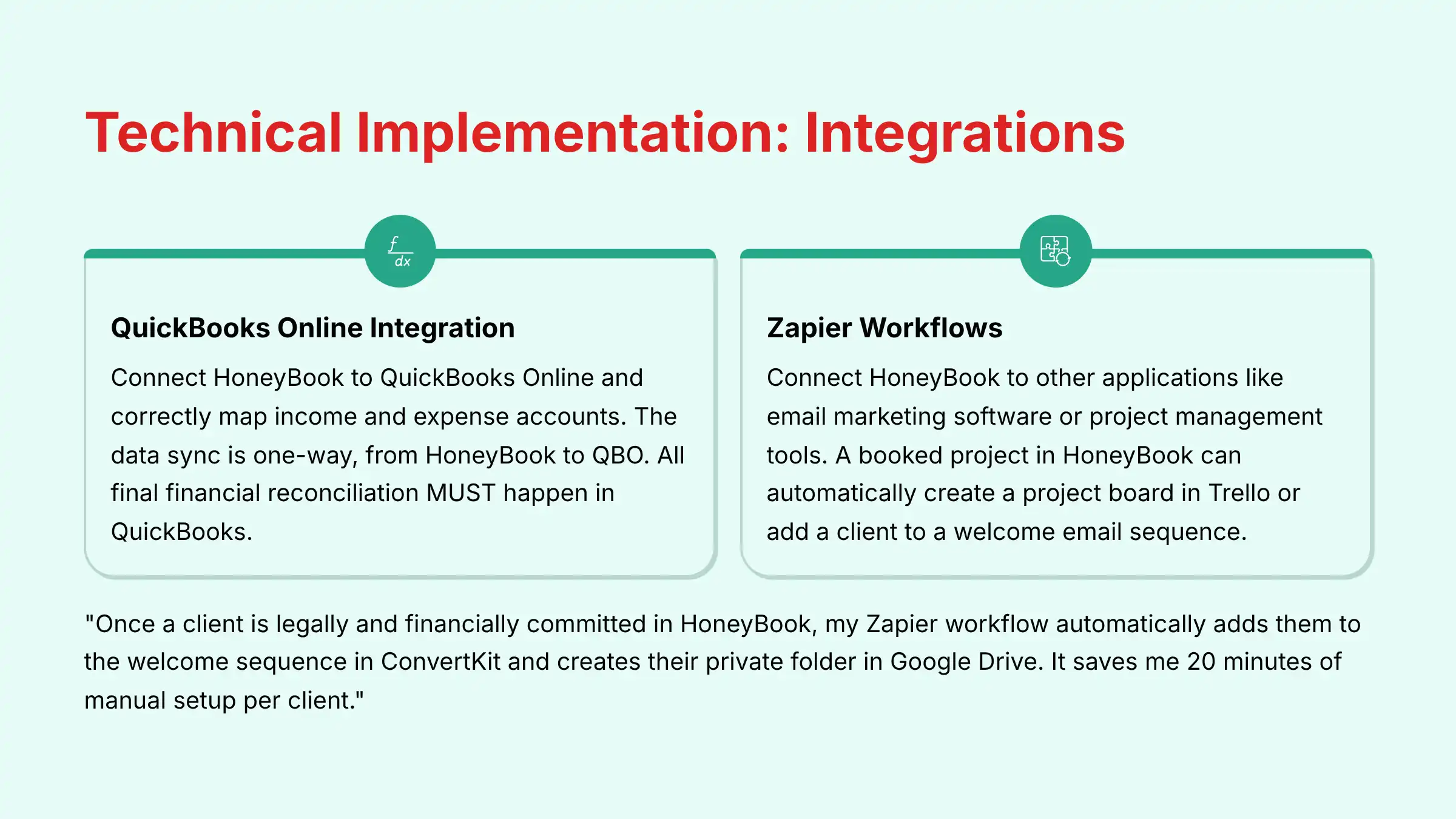

Learning Objective: To connect HoneyBook to QuickBooks Online for accurate financial reporting.
This section covers connecting HoneyBook to QuickBooks Online and correctly mapping income and expense accounts. The integration process includes:
- Authenticating the integration through OAuth
- Mapping HoneyBook package items to QBO products and services
- Mapping payment processing fees to appropriate expense accounts
- Setting up customer matching rules
- Configuring sync preferences and frequency
A paid HoneyBook invoice and its associated processing fee should then sync to the correct accounts in QBO automatically. This is a key step for maintaining clean financial records. To fix the common problem of duplicate customers, make certain client names in HoneyBook and QBO match before your first sync.
⚠️ Financial Accuracy Warning: The data sync is one-way, from HoneyBook to QBO. All final financial reconciliation MUST happen in QuickBooks. Incorrect account mapping can create serious bookkeeping errors, so if you are unsure, please consult with an accountant.
Section 3.4: Advanced Use Case: Custom Workflows with Zapier
Learning Objective: To connect HoneyBook to other applications for a comprehensive business system.
You can connect HoneyBook to other applications like email marketing software or project management tools using Zapier. This tool acts like a set of digital bridges, connecting your separate software islands so they can work together. Popular integration scenarios include:
- Email Marketing Integration:
- Add new HoneyBook clients to MailChimp or ConvertKit
- Trigger welcome email sequences
- Segment clients based on project types
- Project Management Connections:
- Create Trello boards for each new project
- Generate Asana tasks when contracts are signed
- Set up Slack notifications for important milestones
- File Management Automation:
- Create Google Drive folders for each new client
- Sync documents to Dropbox automatically
- Generate backup copies of signed contracts
Zapier allows you to create a scalable tech stack with HoneyBook at the center. As a Systems Strategist I work with noted, “Once a client is legally and financially committed in HoneyBook, my Zapier workflow automatically adds them to the welcome sequence in ConvertKit and creates their private folder in Google Drive. It saves me 20 minutes of manual setup per client.”
For those considering alternatives, explore our comprehensive HoneyBook Best Alternatives guide to understand how different platforms handle integrations and automation.
Part 4: Measuring Success and ROI
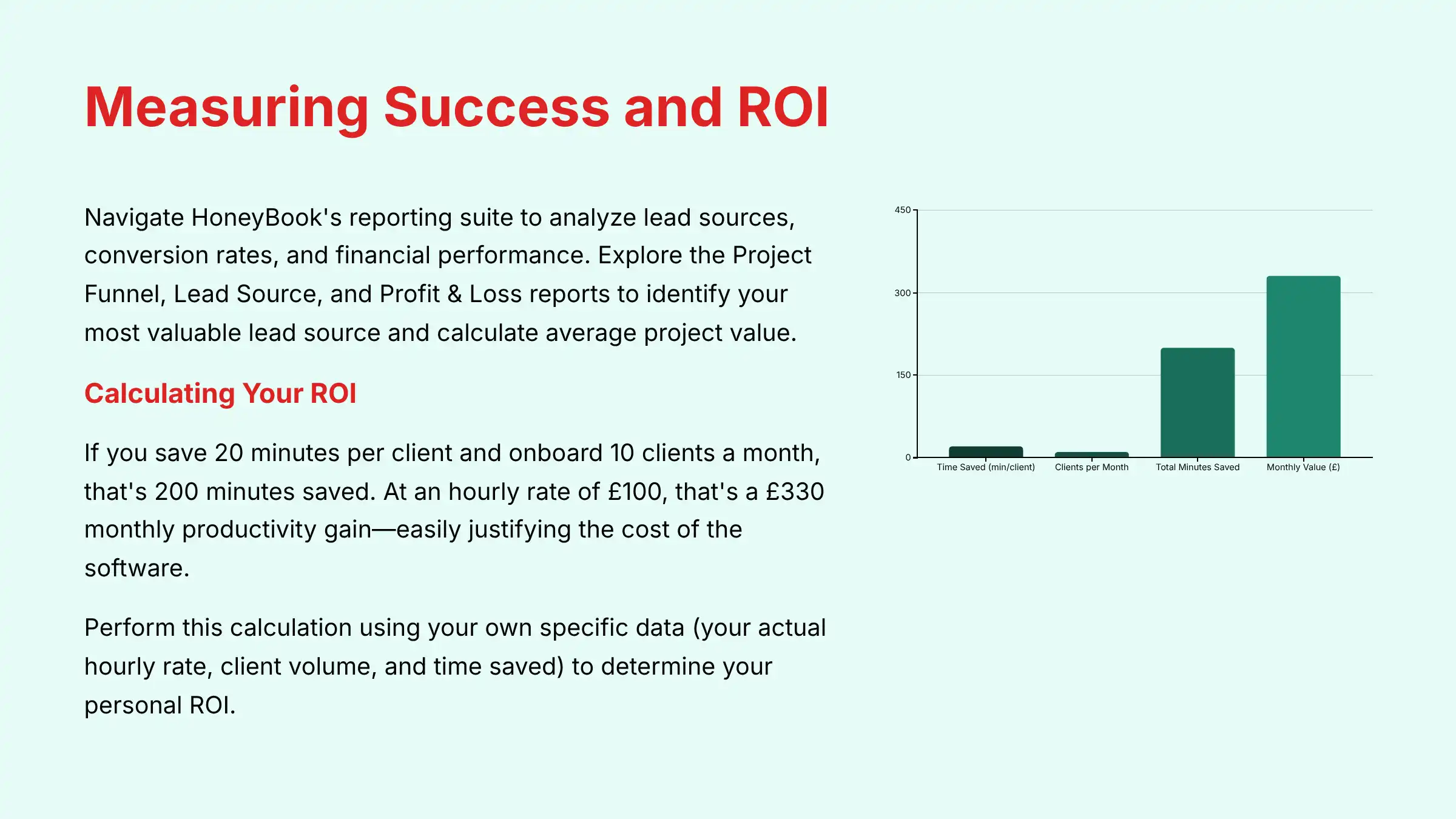

Section 4.1: Using HoneyBook Reports to Measure Business Performance
Learning Objective: To use HoneyBook’s reporting suite for business analysis and ROI calculation.
You can navigate HoneyBook’s reporting suite to analyze lead sources, conversion rates, and financial performance. Key reports to explore include:
- Project Funnel Report:
- Tracks projects through each pipeline stage
- Identifies bottlenecks and conversion rates
- Shows average time spent in each stage
- Lead Source Analysis:
- Identifies your most profitable marketing channels
- Tracks ROI by acquisition source
- Helps optimize marketing spend allocation
- Profit & Loss Reporting:
- Comprehensive financial overview
- Revenue tracking by service type
- Expense categorization and analysis
Soon you will be able to identify your most valuable lead source and calculate your average project value. To fully assess its financial impact, we must look beyond the subscription fee and calculate the Total Cost of Ownership (TCO).
While the ROI from time savings is significant, TCO includes:
- Monthly subscription costs
- Initial setup and template creation time
- Team training investment
- Integration costs with other tools
- Ongoing maintenance and optimization
HoneyBook’s low TCO is a key advantage; its intuitive design minimizes implementation time, meaning new users can achieve a positive ROI within the first one or two months.
For example, you can calculate your time saved by automation. If you save 20 minutes per client and onboard 10 clients a month, that’s 200 minutes saved. At an hourly rate of $100, that’s a $330 monthly productivity gain. This gain easily justifies the cost of the software.
Professional Validation Required: Please perform this calculation using your own specific data (your actual hourly rate, client volume, and time saved) to determine your personal ROI, as results will vary significantly between businesses.
Regularly reviewing these reports can provide insights to guide your marketing and sales strategy.
Final Verdict: Is HoneyBook the Right Choice for Your Business?
After extensive testing and analysis, the bottom line is this: HoneyBook is the superior choice for service-based solopreneurs and small businesses who prioritize ease of use, a polished client experience, and rapid time-to-value.
While other CRMs may offer more granular customization, they often come with a steeper learning curve that acts as a barrier to implementation. HoneyBook’s genius lies in its Smart Files and intuitive automation builder, which allow you to set up a professional, efficient clientflow in hours, not weeks.
HoneyBook excels when you need:
- Quick setup and immediate value
- Professional client-facing documents
- Streamlined payment processing
- User-friendly automation tools
- Excellent customer support
If you save just 2-3 hours of administrative work per month, the platform pays for itself. If you want a tool that gets out of your way and lets you focus on your clients, HoneyBook is an investment that delivers a clear and immediate ROI.
Frequently Asked Questions About HoneyBook Tutorials and Usecase
Is HoneyBook Secure for Handling Client Payments?
Yes, HoneyBook is secure for handling client payments. HoneyBook does not store or process any raw credit card information on its servers. It uses Stripe, a globally trusted and PCI DSS Level 1 compliant payment processor, to handle all transactions. When a client pays an invoice, their data is sent directly to Stripe’s encrypted servers. HoneyBook then uses a secure token to refer to that transaction.
Beyond its reliance on Stripe for PCI compliance, HoneyBook’s security posture is further strengthened by:
- SOC 2 Type II attestation – Independent audit validation
- Encryption-in-transit (TLS 1.2 and higher)
- Encryption-at-rest (AES-256)
- Regular security audits and vulnerability assessments
- Role-based access controls
For maximum security, you should always enable Two-Factor Authentication (2FA) on both your HoneyBook and your Stripe account.
What is the Real ROI of Automating My Workflow in HoneyBook?
The Return on Investment (ROI) from HoneyBook comes from three main areas:
- Time saved: By automating client onboarding, reminders, and follow-ups, users typically save 2-4 hours per week
- Faster payments: Smart Files that combine proposals, contracts, and invoices into one step get paid faster, improving cash flow
- Increased booking value: Using interactive proposals with tiered packages can lead to clients selecting higher-value services
A solopreneur charging $100/hour who saves just 3 hours a month has already generated a 2-3x ROI on their subscription fee. Additional benefits include reduced errors, improved client satisfaction, and better cash flow management.
How Does HoneyBook Compare to Dubsado for a Solopreneur?
When choosing a CRM, the HoneyBook vs. Dubsado question hinges on a key trade-off: usability vs. customizability. Based on our hands-on testing of both platforms across multiple service-based business scenarios:
- HoneyBook excels in simplicity and user experience: Its interface is more intuitive, and the “all-in-one” Smart File concept is easier to master for non-technical users. It’s designed for quick setup and immediate value.
- Dubsado offers deeper customization: Its workflow builder is more powerful and flexible, appealing to users who want to control every detail of their process.
- A Third Axis: The Broader Ecosystem: A competitor like 17hats focuses on integrating financial management more deeply with bookkeeping features. The choice isn’t just about features, but about your core business bottleneck: are you solving for client experience (HoneyBook), process control (Dubsado), or integrated finances (17hats)?
For a solopreneur who prioritizes ease of use and a polished client experience out-of-the-box, HoneyBook is often the better starting point.
My Automation Rule Didn’t Work, What Should I Check First?
Troubleshooting automations requires a systematic approach. Here is a simple checklist to follow:
- Is the Automation Active? Navigate to
Tools > Automationsand check that the master toggle for that specific workflow is turned on. - Did It Meet the EXACT Trigger? The most common error is a mismatch. If the trigger is
New Project via Contact Form, a project you created manually will not fire the automation. - Check the Conditions: If you have a condition like
Project Type is Brand Design, check the project was assigned that exact type. - Review the Activity Log: Inside the specific project, the
Activity & Timelinefeed provides a step-by-step history of all actions, including why an automation might have failed. - Test Mode: Create a test project using your own email to verify the automation works as expected.
Can I Use HoneyBook if I’m Not a Creative Professional?
Yes, HoneyBook is suitable for any service-based business. While HoneyBook built its brand serving creative professionals like photographers and designers, its feature set is perfectly suited for any service-based solopreneur or small business.
Industries successfully using HoneyBook include:
- Business coaches and consultants
- Virtual assistants and online service providers
- Marketing agencies and freelancers
- Event planners and coordinators
- Professional services (lawyers, accountants, etc.)
- Health and wellness practitioners
The core functionality—proposals, contracts, invoices, scheduling, and automation—is industry-agnostic. You can customize project types, packages, and templates to fit any service-based business model.
What Happens if I Decide to Leave HoneyBook? Can I Export My Data?
Data portability is a critical aspect of your data governance strategy and mitigating vendor lock-in. HoneyBook allows you to export your data:
- Client and project lists as CSV files
- All signed contracts and proposals as PDFs
- Financial data and payment history
- Communication logs and notes
Crucial Limitation: It’s important to understand what cannot be exported. The platform’s structure, including your meticulously built automation rules, workflow logic, and Smart File templates, are proprietary to HoneyBook and cannot be migrated to another platform.
Therefore, while your core client and financial data is safe, switching providers would require a complete rebuild of your operational workflows. We recommend a quarterly practice of exporting all signed contracts as PDFs for your independent records.
How Does the QuickBooks Integration Handle Refunds?
The native integration handles refunds correctly, which is vital for accurate bookkeeping. When you process a refund within HoneyBook, it sends this information to QuickBooks Online. QBO then automatically creates a corresponding:
- Refund Receipt for direct payment refunds
- Credit Memo for account credits
- Proper reversal of original income entries
- Documentation of outgoing funds
This correctly reverses the original income and documents the outgoing funds, keeping your Profit & Loss statement accurate. The key is to always initiate the refund in HoneyBook, not QBO, to keep the two systems in sync.
What is the Single Most Important Feature for a New User to Master?
Without a doubt, the Smart File Template is the most important feature to master. A well-built Smart File Template—combining your most popular service package, your standard contract, and a clear payment schedule—turns a multi-step, multi-email process into a single, professional interaction. It’s the engine for the entire platform.
New users should spend their first couple of hours building and perfecting one core Smart File template; this will save them dozens of hours in the long run. Focus on:
- Clear service descriptions with compelling benefits
- Professional pricing presentation
- Comprehensive contract terms
- Streamlined payment collection
For additional questions and detailed answers, visit our comprehensive HoneyBook FAQs section that covers everything from technical troubleshooting to advanced feature usage.
Ready to transform your business operations with HoneyBook? Start your journey today and experience the power of automated clientflow management that has helped thousands of solopreneurs and small businesses scale efficiently.


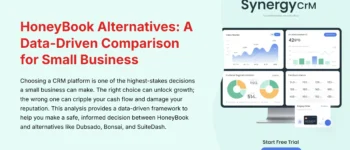
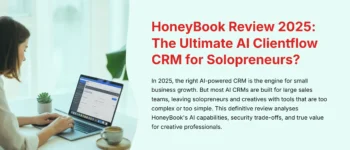
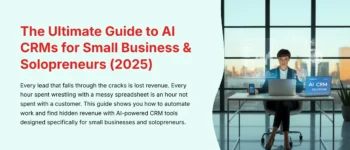
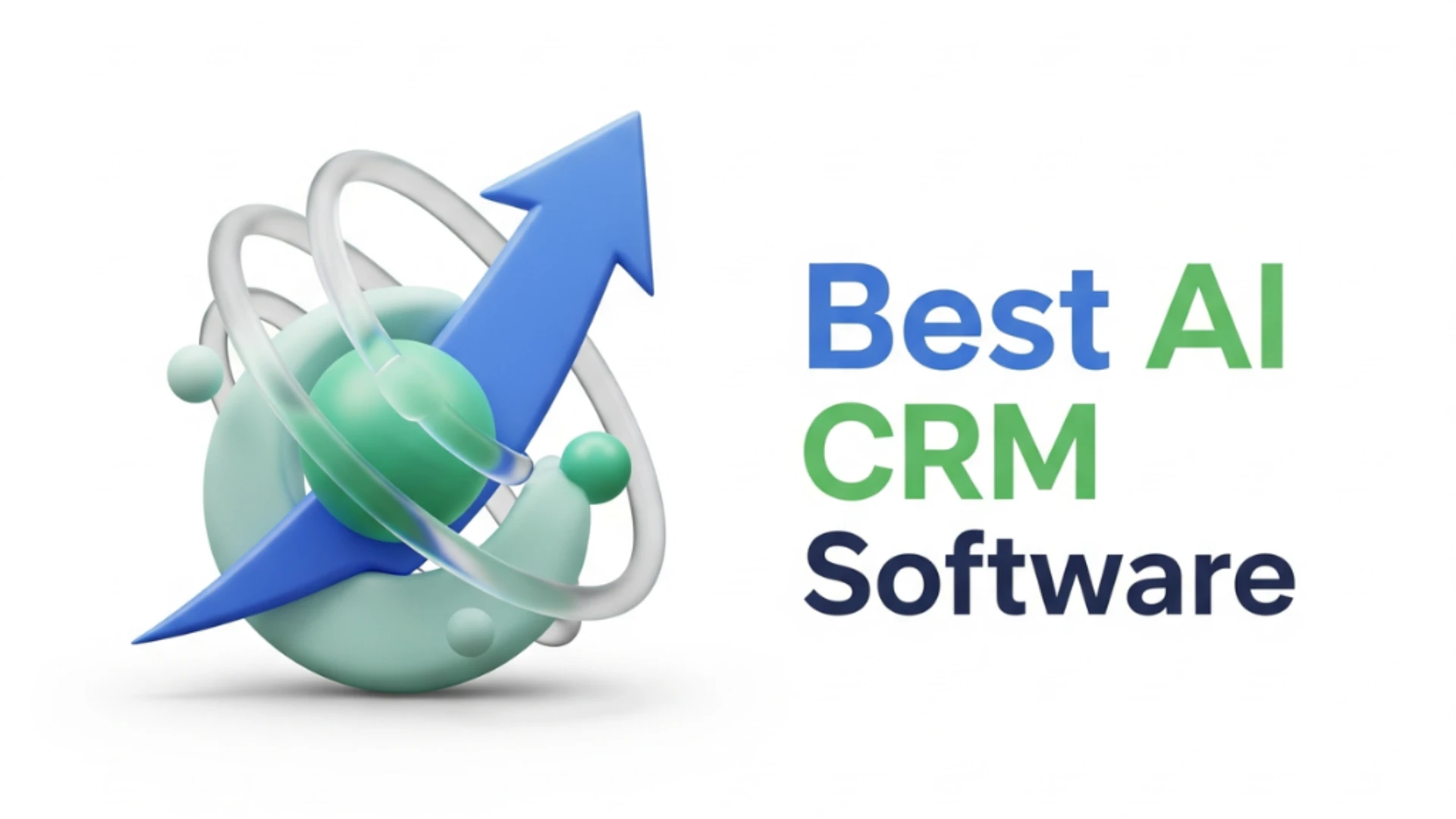
Leave a Reply